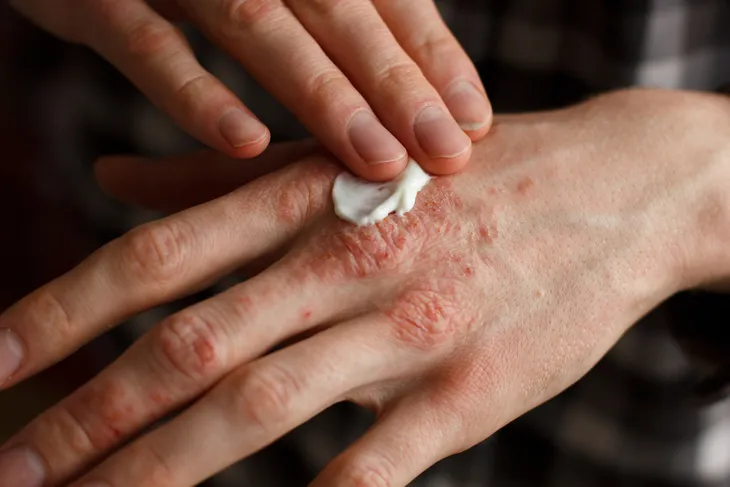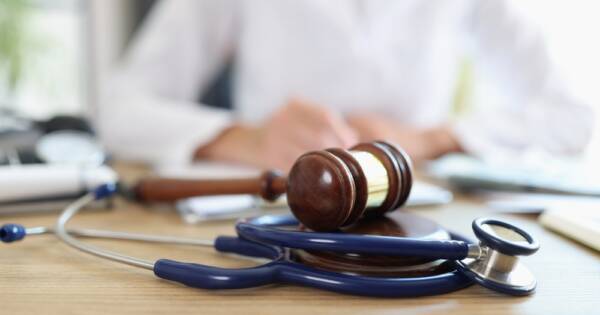Psoriasis is a disease that causes red, scaly patches of skin, usually on the elbows, hands, knees, or scalp. While this condition isn’t contagious, it affects millions of people in the United States alone. It can happen to anyone at any age, but primarily affects people between the ages of 15 and 30. It also occurs equally between men and women.
Most people with psoriasis suffer from uncomfortable symptoms like pain, discomfort, itching, and even burning. These occur alongside the characteristic thick red patches of scaly and flaky skin. Not surprisingly, this condition can be quite distressing to the people affected by it. Nearly 60-percent of people who suffer from psoriasis say it causes a huge problem in their life, particularly for those who suffer from a more severe case. It seems like women and young children struggle the most with the psychological effects of this condition.
Psoriasis doesn’t have to control your life. There are ways to manage this condition and coexist with it. The best thing to do is to educate yourself on the various treatment options, including any remedies that might help soothe the symptoms. You should also learn about any possible triggers and try to eliminate them which in turn will help reduce any symptoms or possible flare ups. You may be required to make a few lifestyle changes.
What is Psoriasis?
Psoriasis is a common inflammatory skin condition, but can also affect the joint.
A unique aspect of psoriasis is that it can come and go. Don’t be fooled when this condition goes into remission, it’s not a matter of will it come back but rather, when. In addition to this, unfortunately psoriasis cannot be cured, at least not yet. But there are many tips and tricks a person can use in order to better manage their symptoms. Some of the most obvious lifestyle changes that can be made are moisturizing more often, quitting smoking, and learning new techniques to help manage stress, explains the Mayo Clinic. While none of these changes will cure this condition, they may help.
One of the most defining characteristics of psoriasis that sets it apart of other skin conditions like eczema is that it grows into thick patches which is sometimes referred to as plaque psoriasis. According to the American Academy of Dermatology, this is the most common form of psoriasis. About 80 to 90-percent of people with psoriasis have plaque psoriasis. However it can come in other forms such as…
- Scalp psoriasis forms on the head with itchy, dry patches.
- Nail psoriasis causes the nails to weaken and discolor.
- Psoriatic arthritis is not as common. It occurs in only about 10 to 20-percent of cases and often results in joint pain, as well as swelling and stiffness.
- Guttate psoriasis typically occurs in childhood. It will result in pink spots, most commonly on the torso, arms, and legs. These spots are small and not thick or raised like plaque psoriasis.
- Inverse psoriasis causes the skin to become red and shiny, as well as inflamed. These patches tend to form in the armpits, breasts, in the groin, or around the skinfolds of the genitals.
- Pustular psoriasis occurs in adults as white, pus-filled blisters. Large sections of the skin will become red and inflamed. This type of psoriasis typically occurs in small, localized areas of the body like the hands or feet. But it can spread further.
- Erythrodermic psoriasis is the most severe type of psoriasis and the most rare. It covers large areas of the body at once causing the skin to appear sunburned. The scales are so large that they come off in sheets. People with this type of psoriasis will often become ill during a flare-up and develop a fever. It can be life threatening.
Again, even though there is no cure, there are plenty of treatment options available and things a person can do to reduce their symptoms.
Causes, Triggers, and Risk Factors
Experts still don’t completely understand psoriasis and aren’t exactly sure what the cause is behind it. What they do know so far is that it is somehow related to the immune system as a problem with T cells and other white blood cells, called neutrophils, explains the Mayo Clinic.
Causes
The exact cause behind this condition is still unknown, but it is believed that there is some kind of genetic link behind it. It is the result of a combination of genes that send the immune system into overdrive. This interference with the immune system is what causes that rapid buildup of skin cells which then forms into patches and lesions. There are about 25 genes that have been identified in people with psoriasis that are different from people without this condition. Any person that has a combination of these genes are at a higher risk for developing psoriasis. It’s still unclear which of these genes has the biggest impact. Health.com says that an estimated 10-percent of people inherit at least one of the genes that cause psoriasis, but only 2 to 3-percent of people will develop the disease. So why does it only occur in a small percentage of people who carry the gene? Some experts believe it is sprung into action due to a trigger like stress, an infection (like strep throat), or certain medications. There are also environmental triggers, for example cold, dry weather or a sunburn.
Experts do consider it to be an autoimmune disease. It is categorized as such because psoriasis causes the immune system to essentially attack itself and any healthy cells, as if it were fighting off an infection. When the body is exposed to a trigger, the body sees it as a threat, sends the immune system into a scramble, and tells it to attack. The body reacts with a buildup of T cells (or white blood cells) which are normally used as a defense. An overdrive of T cells that are growing faster than normal results in those thick, red patches of skin.
Triggers
Triggers can cause the symptoms of psoriasis to become worse, therefore the key to managing this condition and its symptoms is to identify any and all triggers and try to avoid them in the future. This will help limit the amount of flare-ups, as well as how severe these flare-ups may be.
As we’ve already discussed, the immune system is closely tied to psoriasis which is why certain medications and infections are known triggers. Many people might not realize that our gut is also closely linked with our immune system, particularly the bacteria that lives in our gut. There is a very delicate balance of good and bad bacteria in our gut that needs to be maintained in order to stay healthy. When someone contracts an infection it causes the body to react and go on high alert. When medications is taken, it interferes with that gut balance. The result is a severe miscommunication between the body and cells which can trigger this autoimmune condition, psoriasis.
There are a number of factors that have been associated with the onset of psoriasis, including all of the following:
- Skin injury or trauma
- Infection, including bacterial, viral, or fungal
- Allergies
- Smoking
- Excessive drinking
- Lack of vitamin D
- Cold, dry weather
- Sunburn
- Certain medications, such as lithium, beta blockers, antimalarial drugs, iodides
- Nonsteroidal anti-inflammatory drugs (NSAIDs)
- Hormonal changes that occur during puberty, pregnancy, and menopause
Risk Factors
Any person can be born with those genes that indicate whether or not a person will develop psoriasis. However, there are a number of risk factors that make a person more prone to developing this condition. Family history is by far the most common and significant risk factors. If someone closely related to you, such as a parent, has psoriasis, then you’re at risk for developing this disease. If both parents have psoriasis the risk is even higher. Another one is viral and bacterial Infections. People with HIV have a heightened risk of developing psoriasis. In addition to that, anyone with a weakened immune system also has an increased risk, like children and young adults who suffer from recurring infections.
Other less serious, but still common risk factors are stress, obesity, and smoking. Stress can affect our immune system, that’s why people who are in highly stressful situations or who are extremely nervous will get an upset stomach. People who are constantly exposed to stressful situations are more likely to have psoriasis. Excess weight increases the likeliness because many of the lesions associated with all types of psoriasis will develop in the folds of the skin, saysa the Mayo Clinic. Lastly, smoking tobacco not only increases a person’s risk for psoriasis, but those who continue to smoke with this condition will only make their condition more severe.
Conditions Linked to Psoriasis
You’ve probably noticed that psoriasis can resemble other skin conditions like eczema. While the two aren’t linked, psoriasis can be linked to some other health conditions. Anyone who suffers from this disease is at a higher risk for developing other conditions or behaviors called comorbidities:
- Crohn’s disease
- Depression
- Smoking and drinking
- Suicide
- Cardiovascular disease
- Polycystic ovary syndrome (PCOS)
- Osteoporosis
While there haven’t been any scientific links to verify these connections, there is no denying there is a strong connection. For example, studies have found that people with psoriasis can be up to 50-percent more likely to develop depression than people without this condition.
Signs and Symptoms
Psoriasis tends to occur in flare-ups which means the conditions can come and go. It can get better and worse, and even go into remission for a long period of time. Despite all this, the symptoms remain consistent, they include:
- Patches of dry, itchy skin
- Red or pink discoloration on the skin
- Raised, thick patches on the skin
- Stinging or burning sensation
- The skin can become so dry that it cracks and bleeds
- Silvery-white, scaly patches over an affected area. These areas can vary in size, often appearing smaller on children
- Nails become thick, pitted, or discolored
- The nails can separate from the nail beds, a condition known as onycholysis
There are different a few different forms of psoriasis. Most cause similar symptoms, but there are two that result in additional symptoms, including:
- Pustular psoriasis will create pus-filled blisters on the skin. This form of psoriasis can also result in other symptoms like a fever, chills, diarrhea, and even create complications with the kidney and liver.
- Psoriatic arthritis mainly affects the joints causing pain, stiffness, and inflammation. Since it occurs in the joints it can affect a person’s range of motion and even the condition of their nails.
It’s important to note that not everyone feels these symptoms. Some people have completely different signs and symptoms, particularly if they have one of the more rare types of psoriasis. Also, most cases of psoriasis go through “cycle” phases, says Healthline. The condition can become extreme and severe over a period of several weeks or days, but then clear up and seemingly go away. If the patient comes across another trigger, it may come back again. When there are no signs of the condition, it means it has gone into remission, but it doesn’t mean it’s completely gone. It just means you’re currently symptom free.
If you notice any unusual changes in your skin, go see your doctor immediately. You should also seek medical attention if the symptoms become so severe that they are causing extreme discomfort or pain, or if they are interfering with your ability perform daily tasks. Anyone with psoriatic arthritis should have their condition treated as soon as possible in order to prevent any further complications from the disease. In rare cases people can develop an infection related to the psoriasis. If this happens, you may experience a high fever, red streaks, pus, or extreme pain. If this happens, seek medical attention right away.
Complications
People who suffer from psoriasis are at a higher risk of developing other conditions such as:
- Cardiovascular disease, including high blood pressure, abnormal heartbeat, high cholesterol, arterial plaques, and stroke
- Chronic obstructive pulmonary disease (COPD)
- Emotional distress and mood disorders
- Eye diseases, such as conjunctivitis, blepharitis and uveitis
- Kidney disease
- Lymphoma
- Metabolic syndrome
- Nonmelanoma skin cancer
- Obesity
- Other autoimmune diseases, such as celiac, Crohn’s and sclerosis
- Parkinson’s disease
- Pregnancy difficulties, such as premature birth
- Type 2 diabetes
It’s still unclear why these conditions are linked to psoriasis, but it’s likely due to inflammation. Many of the diseases listed above also cause an inflammation reaction in the body. It’s also believed that chronic inflammation caused by psoriasis can lead to the development of other conditions.
Diagnosis
Diagnosis of psoriasis is mostly made clinically by our dermatology with skin examination and detail history taking. However, if your presentation is unclear and resemble other skin conditions, a skin biopsy is often used to help with diagnosis.
Traditional Medical Treatments
Even though there is no cure for psoriasis, there are still many treatments available that work to reduce the symptoms of this condition, including inflammation, scales, slow the growth of skin cells, and even remove plaques. According to Healthline, there are three different categories of treatments:
Topical Treatments
The first line of treatment is always to try creams and ointments that can be applied directly to the skin. These work best for mild to moderate cases of psoriasis.
The most common forms of topical treatment are:
- Topical corticosteroids
- Topical retinoids
- Anthralin
- Vitamin D analogues
- Salicylic acid
- Moisturizer
Systemic Medications
These treatments are used on people who haven’t fared well with any other form of treatment. If this is the case, your doctor may need to use something a little stronger. The following are among the most common oral and injected medications used to treat psoriasis.
- Biologics (alters the immune system and prevents interaction between the immune system and inflammatory pathways)
- Retinoids (reduces skin cell production)
- Cyclosporine (prevents the immune system’s response and can ease symptoms)
- Methotrexate (suppresses the immune system and can cause fewer side effects when used in lower doses, but will cause serious side effects if used long term)
Some of these medications come with serious side effects and risks, so in order to prevent further irritating the skin or potentially dangerous side effects, under a doctor’s supervision, you may have to switch between treatments. You can also use a combination to treatments in order to get the best results.
Light Therapy
This form of therapy uses ultraviolet (UV) or natural light in order to kill the overactive white blood cells that are attacking your healthy skin cells. This will stop that rapid skin growth that is causing red patches to form. Healthline explains that both UV and UVB light can not only prevent the reproduction of cells, but also limit the symptoms of psoriasis.
Dietary Changes
There’s no denying that the food we eat affects our body. The most obvious is through our weight, but some foods (particularly the bad ones) are also known to cause other nasty side effects like bloating and even inflammation. The easiest thing a person with psoriasis can do is to eliminate any of the following foods:
- Animal products
- Processed foods
- Artificial sweeteners, colorings and additives
- White flour
- White sugar
- Anything that may cause an allergic reaction
Foods can’t cure psoriasis or even treat the condition, a change in diet can help manage the condition by making the symptoms less severe. Clean up your diet by eating more whole foods like unprocessed fruits and vegetables, whole wheat grains, beans, legumes, nuts and seeds. Eating more fiber can help provide the body with more phytonutrients which will help reduce any inflammation, reduce cell damage, and support a healthier balance of bacteria in the gut.
According to Healthline, there is some evidence out there that nightshade fruits and vegetables can actually trigger psoriasis symptoms, so try to avoid those. If you’re not sure what nightshade vegetables are, they include things like tomatoes, white potatoes, eggplants, and any pepper-derived foods like paprika and cayenne pepper (this doesn’t include black pepper).
Eating a healthier diet will also contribute to weight loss which can help eliminate one of the common triggers, obesity.
How to Develop a Treatment Plan
The first thing to do after being diagnosed with psoriasis is to come up with a treatment plan. When developing a plan, it’s important to take into account how severe your psoriasis is. Doctors typically like to start with the mildest form of treatment and work their way up the intensity scale, if needed. The only exceptions to this are with psoriatic arthritis and erythrodermic psoriasis. Both of these forms of psoriasis require a more intense treatment plan from the start.
Other things that have to be taken into consideration are any combination treatments. As we mentioned previously, oftentimes treatments will be used in tandem in order to get the best results. You might want to try one traditional treatment as well as an alternative option. They will also be cycled out in courses because some of medications can cause serious side effects when used long term. Some of the common side effects are skin thinning, irritation, weakened hair, hair loss, and reduced effectiveness. All of the pros and cons for each treatment must be weighed in order to figure out which treatment will offer the best benefits and results.
Your treatment should be monitored by a doctor in order to note the effectiveness and to determine if there are any complications. Some forms of psoriasis can cause serious emergency situations, so you should never try to treat this condition solely on your own. Some of the serious complications that can arise are protein loss, cardiac failure, and edema. While these situations are rare, a doctor will be able to create a treatment plan that can help minimize the risk.
Lifestyle Changes
Simple changes to your lifestyle can do wonders for symptoms relief. These changes don’t have to be major, even the slightest change to your daily routine can make a huge difference in the amount of discomfort you’re experiencing as a result of psoriasis.
The biggest and easiest thing to change is stress. Stress presents one of the biggest dangerous to our physical health and it’s something we all struggle to manage, especially in today’s day in age where life can be so busy and overwhelming. If you suffer from psoriasis or any other chronic condition, stress will affect your immune system and hormones. The first step is to identify any major stressors in your life. If possible, eliminate them or at least as many as possible. We understand that there are many factors we cannot control. In these cases, try learning new techniques that can help better manage these stresses. For example:
- Hanging out with friends (be sure to end any toxic relationships)
- Stretching
- Practice yoga
- Meditation
- Read a book
- Get a massage
- Listen to calm music or white noise
- Learn a new hobby or craft like knitting, coloring, or sewing
Another great option that has proved to be helpful for many people with psoriasis is to join a support group. For some, it helps to talk about the problems and frustrations related to this condition with other people who understand. If you can’t find a local group, talk to your doctor. They may be able to recommend one.
If you’re someone who experiences frequent flare-ups, you need to directly address these triggers and try to control them by doing taking the following steps:
- Carry a moisturizer with you at all times
- Use a humidifier to keep the air inside your home moist
- Use insect repellent during the summer
- Limit or eliminate alcohol
- Don’t use skin products that have harsh chemicals or fragrances
- Avoid hot water when bathing and showering
- Avoid scratching
- Quit smoking
- Where loose fitting clothing that doesn’t cause chafing
- Talk to your doctor about alternative treatments
You can also try using natural light to treat psoriasis, but it’s important that it’s only done in small doses. Not surprisingly, a sunburn will only make the condition worse. So you need to find the right balance and never go in the sun without sunscreen. Even a mild sunburn can cause psoriasis to flare. This reaction is called Koebner phenomenon.
How to Choose the Right Doctor
The only way to properly treat psoriasis is to see a doctor, receive a diagnosis, and then team up with either a specialist or a dermatologist who has experience with this condition. We recommend seeing your primary doctor for recommendations, and then doing your own research to find out which doctor would be the right fit for you. By doing your own research, you can compare which doctors have the best reputation. Create a list of doctors that you’d like to meet and ask the following questions:
- How quickly can they meet you?
- How long have they been treating psoriasis?
- How familiar are they with up to date treatments?
- Are they familiar with natural treatments?
- Will there be only one doctor assigned to your case?
- Are they able to design a comprehensive treatment plan?
- Do you rely on research for their treatment?
- Will there services be covered under your insurance plan?
If you are suffering from psoriatic arthritis, you may need to work with a rheumatologist. If your psoriasis affects your mood or causes emotional distress, you might also need to see a therapist. When looking for these healthcare professionals, use the same tactics and questions as what we have listed above. By the end of this process, you’ll have a truly qualified, strong, and competent team that is able to provide the best available treatment.
When working closely with a doctor and specialist, you’ll be able to treat your psoriasis effectively and take the necessary steps to prevent it from becoming any worse. Again, while there is no current cure for psoriasis, there are many treatments available. It will just take some research to find which one works best for you. Keep an eye out for local support groups to help keep you on track with your treatment. You should also rely on close friends and family to help you deal with the emotional impact of this disease.
The best thing to do is to seek treatment from a doctor, talk to them about all the alternative options in terms of treatment. Also, do your own research. Keep up to date with all the advancements in research and technology. While there isn’t a cure today, there could be one tomorrow. Right now the best form of treatment is by using a combination of medication, lifestyle changes, and alternative approaches. All of this will help treat and relieve the symptoms of psoriasis, as well as prevent it from becoming any worse.




